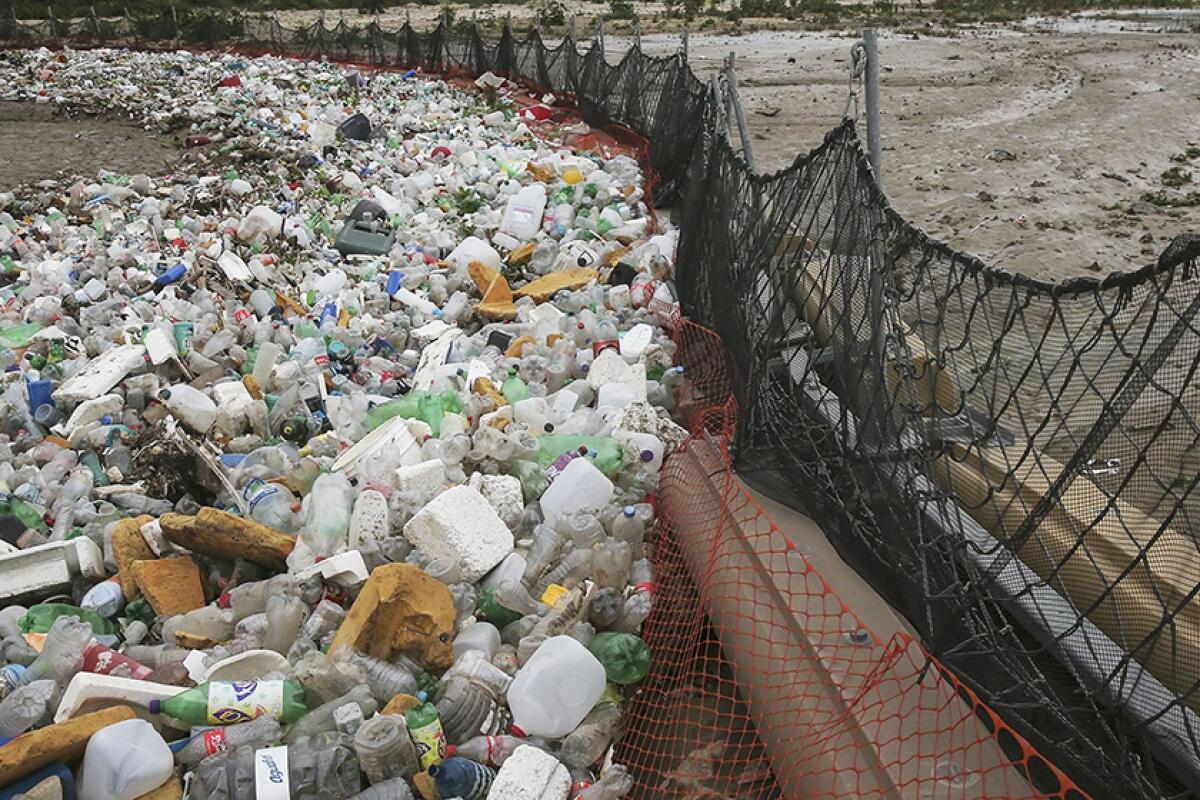Tijuana River sewage flows into San Diego County last year broke all records since 2000

- Share via
SAN DIEGO — The amount of contaminated water laced with raw sewage that is flowing across the U.S.-Mexico border into San Diego County exceeded 44 billion gallons in 2023, the most on record in the last quarter-century, according to a new report.
And this year’s volumes could surpass all records should the region get more damaging rainstorms.
As of June, the U.S. International Boundary and Water Commission, or IBWC, has recorded 33.55 billion gallons of polluted water flows in the Tijuana River, which makes its way into the river valley and the Pacific Ocean. That’s enough water to fill more than 50,000 Olympic swimming pools.
The flows carry stormwater, groundwater and raw sewage to the ocean. Rainstorms in the past couple of years have brought staggering amounts of that polluted stew over the border into San Diego County, flooding some South Bay roads where people have had to be rescued, extending beach closures, and bringing sedimentation and trash to the Tijuana River Valley.
A Jan. 22 storm filled a north levee near the South Bay International Wastewater Treatment Plant with more than 1,100 tons of debris. The cleanup job was finished in late May.
The data were presented Wednesday during an IBWC Citizens Forum meeting, where agency officials gave updates on wastewater infrastructure projects on both sides of the U.S.-Mexico border that are expected to reduce the amount of untreated wastewater in the river.
“There’s a lot of moving pieces that we’re monitoring and managing in order to address these trans-boundary flows and right now there’s a lot of catch-up work that needs to be done,” said Commissioner Maria-Elena Giner, who heads the U.S. section of the binational agency.
On the U.S. side, the IBWC is focused on repairing and expanding the South Bay plant. The 1997 facility has not been properly maintained for decades and does not comply with its Clean Water Act discharge permit.
But it should reach compliance by next month, officials said. To get there, several parts that have been inoperable for years are being repaired or replaced.
For example, all five of the plant’s primary sedimentation tanks, which remove solids from wastewater, had been out of commission since March 2023. Two are now running and a third is expected to come online next week, said Morgan Rogers, the plant’s area operations manager. A minimum of three is required for its permit and all five should be operational by September. The facility also has most of its influent pumps running again, after Tropical Storm Hilary broke five of six. It had no spares. These pumps, costing about $500,000 each, serve as the entryway into the facility’s treatment process. Four new pumps have been ordered, three of which will be spares, said Rogers.
“We were down to one pump because of all the excessive flow and trash and sediment that came through,” he said. “This is critical. We almost shut the plant down.”
The August storm also took out all four of the Hollister Pump Station’s pumps in an area where several horse properties are located. All pumps have been replaced, but the facility is still experiencing malfunctions. Last month, a pressure relief valve on a surge tank stuck open, causing hundreds of thousands of gallons of wastewater to spill onto the street. The station remains out of service while the agency works to replace the tank.
At the same time, the agency is trying to double the South Bay plant’s capacity as part of a major plan to reduce cross-border pollution. The IBWC expects to award a construction contract sometime next month. Even with more than $400 million Congress has allocated to the agency to date, officials estimate a shortage of about $200 million for the expansion project.
On the south side of the border, the Mexican military is rebuilding a crippled sewage treatment plant in Baja California that has discharged 40 million gallons of wastewater per day into the ocean. Mexican officials said the plant will be ready by the end of September or early October.
“We think that’s pretty aggressive,” said Rogers. “Hopefully, we’re on schedule. We’ll see some improvement in the water quality in the ocean down south.”
Mexico is also working on rehabilitating an international collector pipeline. Though its purpose is to transport wastewater to the South Bay plant, its several fractures and leaks contribute to polluted flows in the Tijuana River. And to allow construction work on the pipeline to proceed, a Mexican pumping station must be shut down, typically resulting in tens of millions of gallons per day of extra wastewater into the South Bay plant or the Tijuana River channel.
Construction on the pipeline should be completed this summer, officials said.
The juggling act of fixing long-standing malfunctions and repairing new ones has many South County residents and environmentalists questioning when they’ll find relief from pollution, which has compromised public health, the environment and the economy on both sides of the border.
San Diego Coastkeeper Executive Director Phillip Musegaas is among them. He attended Wednesday’s Citizens Forum.
“We’re appalled,” he said. “This is outrageous that we’ve had this little progress over this amount of time despite the large infusion of federal funding that we’ve seen over $400 million in the past three years. We need to see more progress.”
Coastkeeper and the Coastal Environmental Rights Foundation are suing the binational agency over water quality permit violations for discharging “pollutants such as fecal bacteria, contaminated sediment, heavy metals, and toxic chemicals” into the ocean.
On the federal side, San Diego’s congressional delegation is pushing to add more funds from various agencies and departments to cover the South Bay plant costs.
Rep. Scott Peters (D-San Diego) is also working to secure hazard pay for Border Patrol agents working in polluted waters. And the state Legislature is considering a bill from Sen. Steve Padilla (D-Chula Vista) that would require multinational companies doing business in California to reduce their wastewater discharges or face penalties.
Murga writes for the San Diego Union-Tribune.
More to Read
Sign up for Essential California
The most important California stories and recommendations in your inbox every morning.
You may occasionally receive promotional content from the Los Angeles Times.










